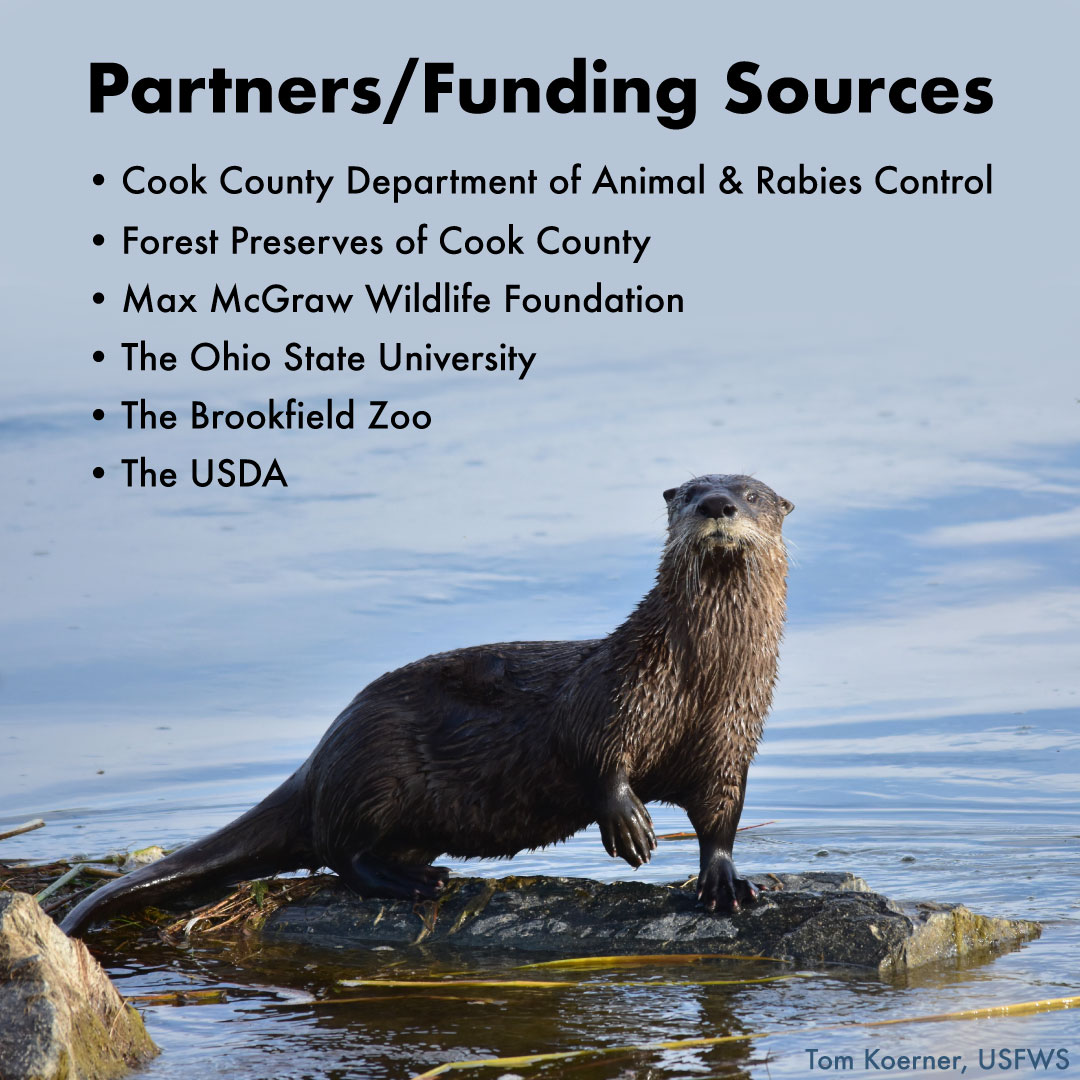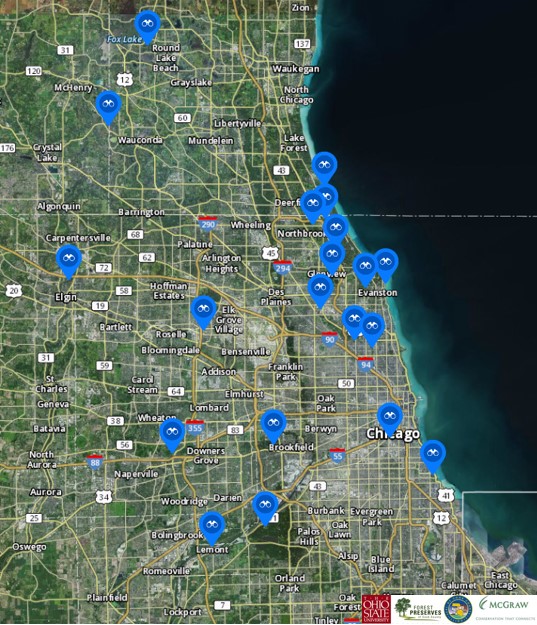Photo by Jeff Nelson.


River Otters Make their Return to Urban Chicagoland Area

After nearly a century’s absence, the charismatic river otter (Lontra canadensis) has begun to return to the Chicagoland area. Human development, unregulated trapping, pollution, and waterway modifications drove this semi-aquatic member of the mustelid family out of Cook County and its unexpected return was quite a surprise for local biologists. The first river otter documented in Cook County was seen in the Sand Ridge Forest Preserve in 2015 and inspired the development of the Urban River Otter Research Project.

After being trapped, implanted with a transmitter, and released, the male otter (henceforth known as RO1501) continued to live in Sand Ridge until early spring in 2016 when he decided to make a move. The Little Calumet River offered him an open channel to travel north to the Whistler Woods Forest Preserve, where he then shocked researchers by traveling more than 15 miles west along the Calumet Sag Channel to the Des Plaines River. Researchers then found him at the Black Partridge Forest Preserve until late 2016 when his transmitter battery died. Four more Cook County otters were monitored in the following years: one in the southwest and three in the northwest.
Five river otters may not seem like much, but their presence in Cook County is a marker of one of the most successful wildlife reintroduction efforts in American history. Before the 1800s, river otters lived in all 48 contiguous states, Canada and Alaska. However, increased human presence and activities reduced river otter range and populations exponentially. These challenges eventually landed otters on Appendix II of the Convention on International Trade in Endangered Species of Wild Fauna and Flora (CITES) and the U.S. Endangered Species List in 1977.

In the late 20th-century, 23 states developed plans to reintroduce river otters back to their historic range. Over a decade, more than 4,000 river otters were relocated across the country, with most obtained from Louisiana and Kentucky. The effort was considered successful as otters reclaimed 90 percent of their historic range by 1998.
The river otter was listed as an Illinois endangered species in 1989. A team of members from the Illinois Endangered Species Protection Board (IESPB) and the Illinois Department of Natural Resources (IDNR) devised a plan that entailed the release of 346 river otters across 15 sites between 1994 and 1997. After completing the releases, river otters were upgraded to threatened in 1999. In 2004 otters were documented in 93 of the state’s 102 counties and by 2005, were projected to have a statewide population of more than 4,000. By 2014, more than 15,000 river otters were estimated to exist within Illinois.
Today, river otters have been observed in all Illinois counties, including the heavily populated Cook County. The first documented river otter residing within the Chicago area occurred in 2015. While it may seem odd that it took otters nearly 20 years to make it to Cook County, consider that the closest otter release site was more than 150 miles to the south. As the population expanded and individuals dispersed, they expanded northward toward Cook County. The otters within the Chicagoland area thus far seem concentrated on the borders of Cook County, but residents have sighted otters within the city itself, including in the Chicago River near Goose Island in 2016, Bubbly Creek in 2019 and the Jackson Park lagoons in 2020.
New Frontier for Otters

River otters have just begun to integrate into urban landscapes, meaning there’s a significant gap in the wildlife community’s knowledge of how they are managing the transition. The Urban River Otter Research Project (URORP) is a novel study examining river otters in the Chicagoland area. Founded by Dr. Stan Gehrt, The Ohio State University, and Chris Anchor, Senior Wildlife Biologist for the Forest Preserve District of Cook County, the project was conceptualized in 2015 when RO1501 was observed. The project officially began in January 2022, following delays resulting from COVID-19 restrictions.
The URORP seeks to understand how river otters are adjusting to urban living and the unique challenges they face. The information needed to accomplish these goals is obtained through locating river otters, observing their movements, and discovering the resources they need to establish a healthy population. Traditional methods for finding and censusing river otters—waterway transects, latrine site surveys, bridge counts and camera-monitoring—will be employed, along with a few modern practices, including reports submitted by citizens. Comparing this data to well-established river otter behaviors and resource usage in rural environments will make for an interesting example of the effects of human density on wildlife.
Even though the project is in its early stages, the URORP wants to share the journey with as many people as possible. They believe getting the people of Chicago involved in the project is of vital importance for many reasons. Primarily, citizens can engage in real wildlife science by reporting river otter sightings to the Otter Sighting Report. The team also wants people to get excited about otters returning to Chicago. As a sentinel species, river otters are a great indicator of water quality, and their presence says Chicago has excellent waterways.
Why Study River Otters?

The presence of river otters is an excellent indicator of the health and biodiversity of an ecosystem. As nonmigratory, aquatic apex predators, river otters are classified as sentinel species. They bioaccumulate toxins present in the bodies of their prey, are incredibly sensitive to water pollutants and human activity, and require an abundant variety of prey species to meet their high energy requirements. Wildlife managers can assess the pollutants within otter habitats based on the levels of toxins present in the livers of deceased animals. The presence or absence of river otters in waterways can serve as an indicator of water quality or the availability of prey species. It is reasonable to think that river otters in Cook County are a potential indication of positive waterway health. A stable otter population presents officials with a way of monitoring ecosystem health.
Having river otters return to Cook County is also a prevailing underdog story. Two main reasons river otter populations were reduced were urbanization and pollution. The fact that otters are selecting to live in urbanized landscapes indicates they may be overcoming an issue that caused them trouble historically. By understanding the behavioral modifications otters adopted to make urbanized living easier, resource managers can create better conservation techniques to support their continued success.

While the Urban River Otter Research Project just started, progress is being made. River otters have been documented for the first time in almost two years. Trail cameras have verified river otters in three distinct areas of Cook County. Fantastic support has been garnered from the local community, with more than 900 people following the social media accounts (see box for links). Those followers have submitted 37 River Otter Sighting Reports to date.
Through the URORP and support from the community, the underdog story of the urban river otter will be recorded, studied and appreciated as these playful, semi-aquatic animals overcome their former challenges and venture forth into a new frontier—the urban jungle.
Read More on the Otter
The River Otter—An Illinois Conservation Success Story
River Otters Are Back in Chicago. A New Research Project Aims to Find Out How They’re Adapting
Chris Anchor, Senior Wildlife Biologist, Forest Preserve District of Cook County (FPDCC), has been a long-term partner, supporter and teacher with the Urban Coyote Research Project. He is the "go-to" person to identify any number of rare wildlife species or provide extensive insight into a challenging research initiative. He has tutored both the new and the experienced, helping to educate scientists-in-the-making. Anchor has been with the FPDCC since 1981 and in his current position since 1986. He spearheaded the idea of researching river otters in Chicago after documenting otters in the Sand Ridge Forest Preserve in 2015.
Zach Hahn graduated from Park University with a B.S. in Biology and a concentration in natural sciences. After graduation, he worked as a technician for several wildlife projects focused on the ecology and conservation of large mammals, from cheetahs to jaguars to wolves to elk. His research interests include human/predator conflict mitigation, urban ecology and interspecific interactions. His current work as an M.S. Research Associate with The Ohio State University is focused on evaluating how river otters are adapting to urban living and the challenges they face.
Submit a question for the author
Question: What (if anything) can I do to help river otters in Illinois. Are there any volunteering opportunities?
I do own a canoe and hope to run the DuPage river a few times this summer from wherever it begins to be navigable via canoe to its termination/entry into the Des Plaines river.
I am a resident of Chicago if that’s helpful info!
Question: Have there been any verified sightings of Otters in the Fox River south of Elgin to the mouth at Ottawa? Thank you
Question: Your study is fascinating. How can I follow the progress of your study? Have any otters been spotted in the DesPlaines River? I kayak the stretch from Romeoville to Lockport which seems like prime otter territory…other than the water pollution. Thanks.
Subscribe to our Newsletter
Explore Our Family of Websites
Similar Reads
A Century of Conservation: How Illinois Brought Back the White-tailed Deer
November 3, 2025 by Kaleigh Gabriel
Responding to an Insidious Invader: Tackling a hydrilla outbreak
November 3, 2025 by Claire Snyder
Using Long-term Data to Improve Sportfish Monitoring in Illinois Rivers
November 3, 2025 by Robert Mooney, Michael Spear, Brian Ickes, Andrya L. Whitten Harris, Jason A. DeBoer, David Glover, James T. Lamer
Caught on Camera
November 3, 2025 by Sheryl DeVore
Return of the Giants: The reintroduction of alligator gar to the Cache River
November 3, 2025 by Mark Denzer, Rob Hilsabeck
The Sport Fish Restoration Act Has Been Supporting Fisheries Management for 75 Years: Part 1
November 3, 2025 by Vic Santucci
Why the Long Face: What is up with the big nose on paddlefish?
November 3, 2025 by Shasta Kamara, Cory Suski
The Culture, History and Values of Modern Trapping
November 3, 2025 by Kathy Andrews Wright
Living with Wildlife in Chicago’s Backyard: What 25 Years of Research Tells Us
August 1, 2025 by Samantha G. Pallazza, Craig Miller
Timing is everything: How habitat, humans, and coyotes influence mammal behavior
August 1, 2025 by Nathan Proudman